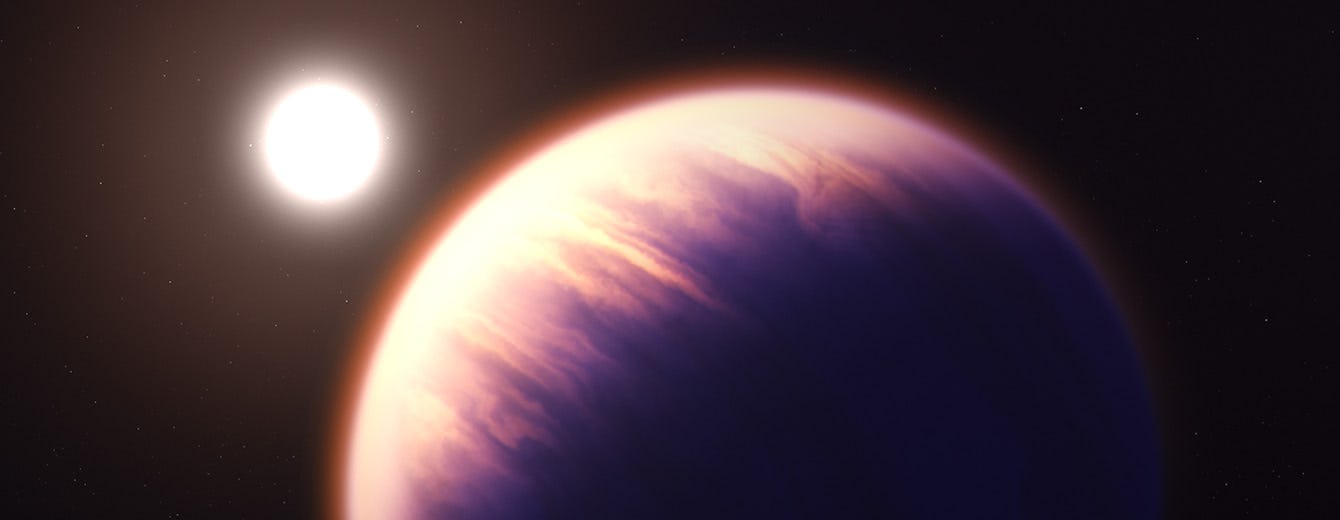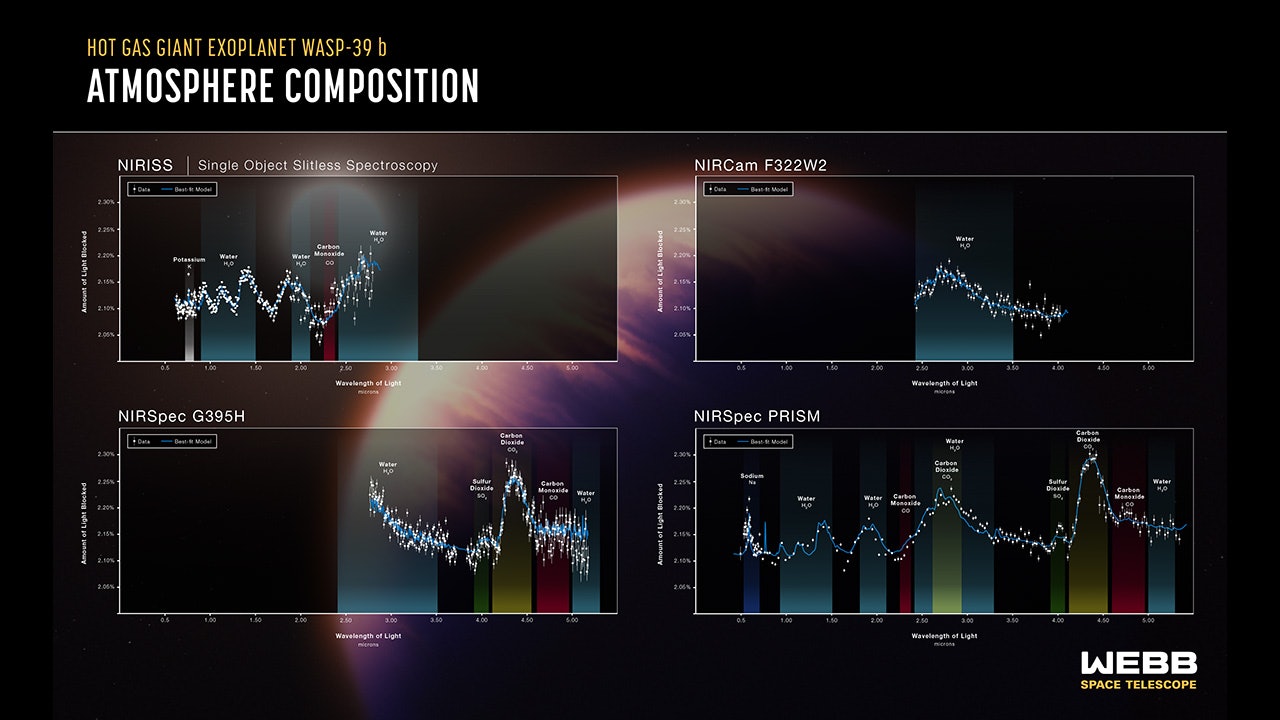
The future of other worlds is looking bright thanks to the James Webb Space Telescope. In newly released findings from the Webb Early Release Science program, researchers obtained the first-ever detailed chemical profile of an exoplanet’s atmosphere, and even came to understand the likely shapes of alien clouds in the planet’s skies.
The exoplanet in question is WASP-39b, a roughly Saturn-sized gas giant orbiting close to its star about 700 light-years from Earth. Scientists have studied WASP-39b in the past using the Hubble and Spitzer Space Telescopes to identify water in the exoplanet’s atmosphere in 2018, while Webb first detected carbon dioxide on the planet back in August.
But the new Webb observations released on Tuesday are a much broader and more detailed view of WASP-39b's atmosphere, and even provide clues as to how such a large planet ended up orbiting closer to its star than the planet Mercury does to our Sun. And moreover, the new findings fulfill the overarching goal of the Webb Early Release Science program, which was to test and demonstrate what the new flagship space telescope is really capable of.
“Without this program, we probably wouldn't have been able to do this kind of detailed analysis on one single planet as rapidly and efficiently as we did,” Adina Feinstein, a University of Chicago graduate student and lead author of a forthcoming paper on the new Webb results, tells Inverse. “And the precision that we're getting is kind of beyond our wildest dreams.”
What’s New — While past studies identified water and carbon dioxide in the atmosphere of WASP-39b, the new research revealed a wider range of chemicals. Water vapor and carbon dioxide were found, but also carbon monoxide, sodium, potassium and, importantly, sulfur dioxide, which has never been detected in an exoplanet atmosphere before.
“What's really interesting about sulfur dioxide is the only way you can get that in a planetary atmosphere is through a process called photochemistry,” Feinstein says. “So this is one of the first pieces of evidence we have of star-planet interaction, where because the planet is so close to its star, and it's getting highly irradiated, you can get these kinds of species that formed.”

The findings also help explain how WASP-39b came to orbit so close to its star, she adds. The new Webb data show a low carbon to oxygen ratio in the exoplanet’s atmosphere, meaning there’s a lot more molecules containing oxygen present, such as a water vapor, than molecules containing carbon, such as methane, which didn’t show up at all in the new observations.
Because carbon containing molecules tend to accumulate on planets more when they are further away from a star, according to Feinstein, with less carbon accumulating if that planet migrates closer to a star, scientists now believe WASP-39b formed very far from its star, not anywhere near where it is today on its very short orbital period, and then migrated inwards,” she says.
As powerful as the Webb telescope is, it cannot directly image a planet as distant as WASP-39b, and instead detects information carried by the light of its star as it passes through the exoplanet’s atmosphere as the planet passes in front of its star from Webb’s vantage point. But that information provides more than the chemical fingerprints of the WASP-39b’s atmosphere; it can also help scientists paint a picture of what the exoplanet would look like if humans could pay it a visit. The evidence from the new Webb data suggests, for instance, “that WASP-39b has what are known as patchy clouds around the planet’s terminator, which is very similar to kind of what we see here on Earth, where we have regions with lots of clouds and regions of not a lot of clouds,” Feinstein says. This is some of the first, tentative evidence of this kind of cloud structure on an exoplanet.”
The results are detailed in five papers still pending publication, but available publicly on the academic preprint server arxiv.org.
How did they do it? — The basics of the new observations of WASP-39b are tried and true: scientists point a telescope at a distant star and wait for an exoplanet to pass between the star and the telescope, “transiting” the star. The telltale dip in a stars brightness caused by an exoplanet’s passing is one of the methods exoplanet hunters use to find these alien worlds in the first place, but scientists can also study those exoplanets by observing the starlight that passes through the planet’s atmosphere during a transit.
Webb can super charge such observations of exoplanet atmosphere by virtue of the sheer scale and power of the new telescope. With a primary mirror 21-feet in diameter, compared with the eight-feet of Hubble’s mirror, and the 2.8-feet of Spitzer’s mirror, Webb can simply gather and magnify much more light, seeing and revealing more.
But the record-breaking optics are only part of the story. Webb’s exquisitely tuned instruments, getting put through their paces as part of the Early Release Science program, were able to parse information out of reach and out of focus for Hubble and Spitzer.
It was the Near-Infrared Imager and Slitless Spectrograph, or NIRISS instrument, for instance, that detected the carbon to oxygen ratio that tells astronomers so much about the origins of WASP-39b.
“Hubble didn't have the resolution that we needed to be able to resolve this feature,” Feinstein says.
Meanwhile it was Webb’s Near-Infrared Spectrometer, or NIRSpec, that detected the sulfur dioxide that demonstrates active photochemistry taking place on WASP-39b.
Spectrometers like NIRSpec and NIRISS break apart light by wavelengths, and since scientists know what molecules absorb light at different wavelengths, the resulting spectrum tells scientists what molecules are or are not present in an exoplanet atmosphere. It turns out that specializing in observing infrared light, which Webb does, is better for this kind of exoplanet spectrometry than a more general telescope like Hubble, which observes in ultraviolet, visible, and some infrared light.
So far, Webb’s early observations are over performing to the point of surprise for scientists like Feinstein.
“We've had to go back and forth between whether we believe the data,” she says, “or whether we believe our older models.”
What’s Next — As part of the Early Release Science program, the new findings are meant to help scientists predict what they can expect out of Webb in the years to come.
In the short term, according to Feinstein, that means more papers on WASP-39b and other exoplanets coming out of Early Release Science program data. And then there are also exoplanet observations taking place right now as part of Webb’s first year of official scientific observations, cycle one, which includes fascinating worlds such as the TRAPPIST-1 planets, small rocky worlds about 40 light-years from Earth.
Over the long term, these observations will only grow more detailed, helping scientists to understand the true range of diversity of worlds outside our Solar System, and in turn helping us to understand our own place in the cosmos.
“We're really starting to get a sense of the demographics of what exoplanet atmospheres look like,” Feinstein says. “It really is like the dawn of a new era for exoplanet atmospheres.”







